Sambucus nigra
| Sambucus nigra | |
|---|---|
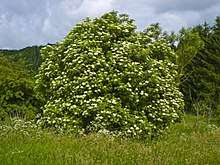 | |
| Shrub in flower | |
| Scientific classification | |
| Kingdom: | Plantae |
| Clade: | Angiosperms |
| Clade: | Eudicots |
| Clade: | Asterids |
| Order: | Dipsacales |
| Family: | Adoxaceae |
| Genus: | Sambucus |
| Species: | S. nigra |
| Binomial name | |
| Sambucus nigra | |
Sambucus nigra is a species complex of flowering plants in the family Adoxaceae native to most of Europe and North America.[1] Common names include elder, elderberry, black elder, European elder, European elderberry and European black elderberry.[2][3] It grows in a variety of conditions including both wet and dry fertile soils, primarily in sunny locations.
The English term for the tree is not believed to come from the word "old" but from the Anglo Saxon æld, meaning fire, because the hollow stems of the branches were used as bellows to blow air into a fire.[4]
Description
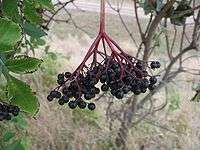
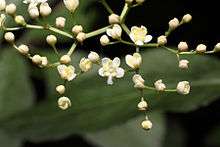
It is a deciduous shrub or small tree growing to 6 m (20 ft) tall and wide,[5] rarely 10 m (33 ft) tall). The bark, light grey when young, changes to a coarse grey outer bark with lengthwise furrowing, lenticels prominent.[6] The leaves are arranged in opposite pairs, 10–30 cm long, pinnate with five to seven (rarely nine) leaflets, the leaflets 5–12 cm long and 3–5 cm broad, with a serrated margin. The young stems are hollow.[7]
The hermaphrodite flowers have five stamens[8] and are borne in large, flat corymbs 10–25 cm diameter in late spring to mid summer, the individual flowers ivory white, 5–6 mm diameter, with five petals; they are pollinated by flies.
The fruit is a glossy dark purple to black berry 3–5 mm diameter, produced in drooping clusters in late autumn;[5] they are an important food for many fruit-eating birds, notably blackcaps.
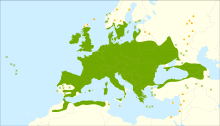
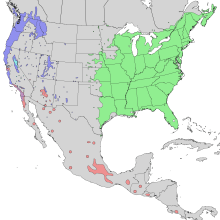
Subspecies
There are several other closely related species, native to Asia and North America, which are similar, and sometimes treated as subspecies of Sambucus nigra. The blue or Mexican elderberry, Sambucus mexicana, is now generally treated as one or two subspecies of Sambucus nigra subsp. canadensis[9] and Sambucus nigra subsp. caerulea.[10]
Habitat
Hedges, waste-ground roadsides and woods.[8] S. nigra is recorded as very common in Ireland in hedges as scrub in woods.[11][12]
Cultivation
Some selections and cultivars have variegated or coloured leaves and other distinctive qualities, and are grown as ornamental plants.
The following cultivars have gained the Royal Horticultural Society's Award of Garden Merit:
Culinary uses
The dark blue/purple berries can be eaten when fully ripe but are mildly poisonous in their unripe state.[16] All green parts of the plant are poisonous, containing cyanogenic glycosides (Vedel & Lange 1960). The berries are edible after cooking and can be used to make jam, jelly, chutney and Pontack sauce.
The flowerheads are commonly used in infusions, giving a very common refreshing drink in Northern Europe and the Balkans. Commercially these are sold as Elderflower cordial.[17] In Europe, the flowers are made into a syrup or cordial (in Romanian: Socată, in Swedish: fläder(blom)saft, in Danish: hyldeblomstsaft / hyldedrik), which is diluted with water before drinking. The popularity of this traditional drink has recently encouraged some commercial soft drink producers to introduce elderflower-flavoured drinks (Fanta Shokata, Freaky Fläder). The flowers can also be dipped into a light batter and then fried to make elderflower fritters. In Scandinavia and Germany, soup made from the elder berry (e.g. the German Fliederbeersuppe) is a traditional meal.
Both flowers and berries can be made into elderberry wine, and in Hungary an elderberry brandy is made that requires 50 kg of fruit to produce 1 litre of brandy. In south-western Sweden, it is traditional to make a snaps liqueur flavoured with elderflower. Elderflowers are also used in liqueurs such as St-Germain, and in a mildly alcoholic sparkling elderflower 'champagne'.
In Beerse, Belgium, a variety of Jenever called Beers Vlierke is made from the berries.
Traditional medicine

This plant is used as a medicinal plant by native peoples and herbalists.[18][19] Stembark, leaves, flowers, fruits, and root extracts are used in bronchitis, cough, upper respiratory cold infections, and fever.
Sambucus nigra fruits and flowers have been used in traditional Austrian medicine – internally (fruits as tea, jelly, juice, or syrup; flowers as tea or syrup) for treatment of disorders of the respiratory tract, mouth, gastrointestinal tract, and skin, and for viral infections, fever, colds, and influenza.[20] The first book about the medicinal properties of the plant was written by German physician Martin Blochwich in the 1620s.
The dried corollas and stamens of Sambucus nigra L. (Sambucus, British Pharmaceutical Codex, 1949) have been used as a vehicle for eye and skin lotions, while the fruits are to promote urination.[21]
Diseases
Like other elderberries, Sambucus nigra is subject to elder whitewash fungus and jelly ear fungus.
Wildlife value
Elder rates as fair to good forage for animals such as mule deer, elk, sheep and small birds. It is classified as nesting habitat for many birds, including hummingbirds, warblers, and vireos. Elderberries are a favorite food for migrating band-tailed pigeons in northern California, which may sometimes strip an entire bush in a short time.
It is also good cover for large and small mammals.[22]
Elder is cited as a poisonous plant for mammals, and as a weed in certain habitats.[23] All parts of the plant except for the flowers and ripe berries (but including the ripe seeds) are poisonous, containing the cyanogenic glycoside sambunigrin (C14H17NO6, CAS number 99-19-4).[24] The bark contains calcium oxalate crystals.
Other uses
The strong-smelling foliage was used in the past, tied to a horse's mane, to keep flies away while riding.
References
- ↑ "Flora Europaea Search Results". Rbg-web2.rbge.org.uk. Retrieved 13 October 2017.
- ↑ "Sambucus nigra". Integrated Taxonomic Information System.
- ↑ "Plants Profile for Sambucus nigra (black elderberry)". Plants.usda.gov. Retrieved 13 October 2017.
- ↑ "Elder (Sambucus nigra) - British trees -". Woodland Trust. Retrieved 3 November 2017.
- 1 2 RHS A-Z encyclopedia of garden plants. United Michael and Vikram: Dorling Kindersley. 2008. ISBN 1405332964.
- ↑ Clapham, A.R., Tutin, T.G. and Warburg,E.F. 1968 Excursion Flora of the British Isles Second Edition Cambridge. ISBN 0-521-04656-4
- ↑ Vedel, H. and Lange, J. 1971. Trees and Bushes in Wood and Hedgerow. p.196. Methuen and Co. Ltd. ISBN 0416-61780-8
- 1 2 Parnell, J. and Curtis, T. 2012. Webb's An Irish Flora. Cork University Press. ISBN 978-185918-4783
- ↑ "Sambucus mexicana". Calflora. Retrieved 2012-07-16.
- ↑ "Sambucus nigra ssp. caerulea". Calflora. Retrieved 2012-07-16.
- ↑ Hackney, P. 1992. Stewarts and Corry's Flora of the North-east of Ireland. Institute of Irish Studies The Queen's University of Belfast. ISBN 0 85389 446 9(HB)
- ↑ Webb, D.A., Parnell, J. and Doogue, D. 1996. An Irish Flora. Dundalgan Press Ltd, Dundalk. ISBN 0-85221-131-7
- ↑ "RHS Plant Selector Sambucus nigra 'Aurea' AGM / RHS Gardening". Apps.rhs.org.uk. Retrieved 2012-07-16.
- ↑ "RHS Plant Selector Sambucus nigra f. laciniata AGM / RHS Gardening". Apps.rhs.org.uk. Retrieved 2012-07-16.
- ↑ "RHS Plant Selector Sambucus nigra f. porphyrophylla 'Gerda' PBR AGM / RHS Gardening". Apps.rhs.org.uk. Retrieved 2012-07-16.
- ↑ Professor Julia Morton, University of Miami
- ↑ Kikbracken, J. 1995. Easy way guide Trees. Larousse.
- ↑ "Sambucus nigra Elderberry - European Elder, Black elderberry, American black elderberry, Blue elderberry, Europea PFAF Plant Database". Pfaf.org. Retrieved 13 October 2017.
- ↑ "Mojave Desert Large Shrubs and Vines". Offroadinghome.djmed.net. Retrieved 2012-07-16.
- ↑ Vogl S, Picker P, Mihaly-Bison J, Fakhrudin N, Atanasov AG, Heiss EH, Wawrosch C, Reznicek G, Dirsch VM, Saukel J, Kopp B (7 October 2013). "Ethnopharmacological in vitro studies on Austria's folk medicine – An unexplored lore in vitro anti-inflammatory activities of 71 Austrian traditional herbal drugs". J Ethnopharmacol. 149 (3): 750–771. doi:10.1016/j.jep.2013.06.007. PMC 3791396. PMID 23770053.
- ↑ Christophe Wiart (2006), Medicinal Plants of the Asia-Pacific: Drugs for the Future?, World Scientific, ISBN 981-256-341-5
- ↑ "Sambucus nigra subsp. cerulea". Fs.fed.us. Retrieved 13 October 2017.
- ↑ "Sambucus nigra". Germplasm Resources Information Network (GRIN). Agricultural Research Service (ARS), United States Department of Agriculture (USDA). Retrieved 12 December 2017.
- ↑ Campa C, Schmitt-Kopplin P, Cataldi TR, Bufo SA, Freitag D, Kettrup A (2000). "Analysis of cyanogenic glycosides by micellar capillary electrophoresis". Journal of Chromatography B. 739: 95–100. doi:10.1016/S0378-4347(99)00375-8. PMID 10744317.
Further reading
- Blanchan, Neltje (1900). Wild Flowers: An Aid to Knowledge of our Wild Flowers and their Insect Visitors. New York City: Doubleday. OCLC 16950204.
- Rushforth, K. (1999). Trees of Britain and Europe. HarperCollins ISBN 0-00-220013-9.
- Bratu, Mihaela Mirela; Doroftei, Elena; Negreanu-Pirjol, Ticuta; Hostina, Corina; Porta, Sepp (April 2012). "Determination of Antioxidant Activity and Toxicity of Sambucus nigra Fruit Extract Using Alternative Methods". Food Technology and Biotechnology. 50 (2): 177–182. ISSN 1330-9862.